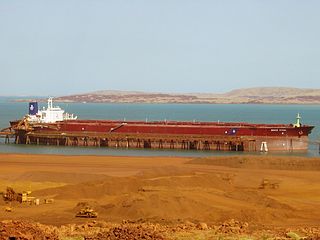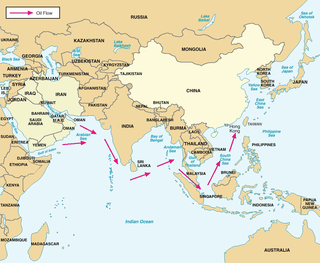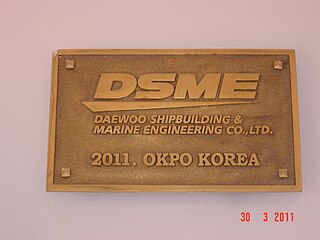
A container ship is a cargo ship that carries all of its load in truck-size intermodal containers, in a technique called containerization. Container ships are a common means of commercial intermodal freight transport and now carry most seagoing non-bulk cargo.

Panamax and New Panamax are terms for the size limits for ships travelling through the Panama Canal. The limits and requirements are published by the Panama Canal Authority (ACP) in a publication titled "Vessel Requirements". These requirements also describe topics like exceptional dry seasonal limits, propulsion, communications, and detailed ship design.

A cargo ship or freighter is a merchant ship that carries cargo, goods, and materials from one port to another. Thousands of cargo carriers ply the world's seas and oceans each year, handling the bulk of international trade. Cargo ships are usually specially designed for the task, often being equipped with cranes and other mechanisms to load and unload, and come in all sizes. Today, they are almost always built of welded steel, and with some exceptions generally have a life expectancy of 25 to 30 years before being scrapped.

A bulk carrier or bulker is a merchant ship specially designed to transport unpackaged bulk cargo—such as grain, coal, ore, steel coils, and cement—in its cargo holds. Since the first specialized bulk carrier was built in 1852, economic forces have led to increased size and sophistication of these ships. Today's bulk carriers are specially designed to maximize capacity, safety, efficiency, and durability.

A tanker is a ship designed to transport or store liquids or gases in bulk. Major types of tankship include the oil tanker, the chemical tanker, cargo ships, and a gas carrier. Tankers also carry commodities such as vegetable oils, molasses and wine. In the United States Navy and Military Sealift Command, a tanker used to refuel other ships is called an oiler but many other navies use the terms tanker and replenishment tanker. Tankers were first developed in the late 19th century as iron and steel hulls and pumping systems were developed. As of 2005, there were just over 4,000 tankers and supertankers 10,000 LT DWT or greater operating worldwide.

MS Berge Stahl was a bulk carrier. Until the delivery of MS Vale Brasil in 2011 she was the longest and largest iron ore carrier in the world. She was registered in Comoros. Before that, she was registered in Douglas, Isle of Man, Stavanger, Norway as well as in Monrovia, Liberia.

"Suezmax" is a naval architecture term for the largest ship measurements capable of transiting the Suez Canal in a laden condition, and is almost exclusively used in reference to tankers. The limiting factors are beam, draft, height, and length.
The Baltic Dry Index (BDI) is a shipping freight-cost index issued daily by the London-based Baltic Exchange. The BDI is a composite of the Capesize, Panamax and Supramax timecharter averages. It is reported around the world as a proxy for dry bulk shipping stocks as well as a general shipping market bellwether.

Handymax and Supramax are naval architecture terms for the larger bulk carriers in the Handysize class. Handysize class consists of Supramax, Handymax, and Handy. The ships are used for less voluminous cargoes, and different cargoes can be carried in different holds. Larger capacities for dry bulk include Panamax, Capesize and Very Large Ore Carriers and Chinamax.

Malaccamax is a naval architecture term for the largest tonnage of ship capable of fitting through the 25-metre-deep (82 ft) Strait of Malacca. Bulk carriers and supertankers have been built to this tonnage, and the term is chosen for very large crude carriers (VLCC). They can transport oil from Arabia to China. A typical Malaccamax tanker can have a maximum length of 333 m (1,093 ft), beam of 60 m (197 ft), draught of 20.5 m (67.3 ft), and tonnage of 300,000 DWT.

Handysize is a naval architecture term for smaller bulk carriers or oil tanker with deadweight of up to 50,000 tonnes, although there is no official definition in terms of exact tonnages. Handysize is also sometimes used to refer to the span of up to 60,000 tons, with the vessels above 35,000 tonnes referred to as Handymax or Supramax.

The draft or draught of a ship's hull is the vertical distance between the waterline and the bottom of the hull (keel). The draught of the vessel is the maximum depth of any part of the vessel, including appendages such as rudders, propellers and drop keels if deployed. Draft determines the minimum depth of water a ship or boat can safely navigate. The related term air draft is the maximum height of any part of the vessel above the water.

An oil tanker, also known as a petroleum tanker, is a ship designed for the bulk transport of oil or its products. There are two basic types of oil tankers: crude tankers and product tankers. Crude tankers move large quantities of unrefined crude oil from its point of extraction to refineries. Product tankers, generally much smaller, are designed to move refined products from refineries to points near consuming markets.
Portline Transportes Marítimos Internacionais, SA., often simply called Portline is a Portuguese shipping company. The company has diverse business activities, including dry bulk, containerised, and break-bulk cargo shipping, shipping agency, forwarding and logistics services, ship management and manning, ship brokerage and chartering, and a container depot service.

Chinamax is a standard of ship measurements that allow conforming ships to use various harbours when fully laden, the maximum size of such a ship being 24 m (79 ft) draft, 65 m (213 ft) beam and 360 m (1,180 ft) length overall. An example of ships of this size is the Valemax bulk carriers.

MS Ore Brasil, previously known as Vale Brasil, is a very large ore carrier owned by the Brazilian mining company Vale. She is the first of seven 400,000-ton very large ore carriers (VLOC) ordered by Vale from Daewoo Shipbuilding & Marine Engineering in South Korea and twelve from Jiangsu Rongsheng Heavy Industries in China, which are designed to carry iron ore from Brazil to Asia along the Cape route around South Africa. While close to the specifications of Chinamax, these ships are generally referred to as Valemax vessels by Vale. They are the largest bulk carriers ever built.

Valemax ships are a fleet of very large ore carriers (VLOC) owned or chartered by the Brazilian mining company Vale S.A. to carry iron ore from Brazil to European and Asian ports. With a capacity ranging from 380,000 to 400,000 tons deadweight, the vessels meet the Chinamax standard of ship measurements for limits on draft and beam. Valemax ships are the largest bulk carriers ever constructed, when measuring deadweight tonnage or length overall, and are amongst the longest ships of any type currently in service.
MS Nordic Orion is a Danish bulk carrier registered in Panama City. A coal and ore carrier, Nordic Orion has a capacity of 75,603 tonnes deadweight (DWT). It was built in 2011 by Oshima Shipbuilding. Nordic Orion has an ice-strengthened hull, and it is notable for being the first large sea freighter to transit the Arctic Northwest Passage. It is owned and operated by Nordic Bulk Carriers.

Foremost Group is a privately held American shipping company, headquartered in New York City. It operates globally, chartering vessels to companies in the dry bulk shipping industry. Its clients include Bunge, Cargill, Dreyfus (Rotterdam), MOL (Tokyo) and NYK Line (Tokyo). Foremost Group was founded in 1964 by James Si-Cheng Chao and his wife Ruth Mulan Chu Chao, who each immigrated to the United States from China by way of Taiwan. Its chair and CEO since 2008 is Angela Chao, the sixth daughter of the company's founders and the third of their children born in the United States.

















